Boric acid for grapes
Content:
Poor environmental conditions at the present time do not allow people to get a good harvest in large quantities. This factor significantly disappoints gardeners and summer residents, who put their soul and all their time into their garden. The vineyard must be fed during the period of the appearance of berry ovaries, ripening of fruits and the appearance of flowers. Boric acid for grapes is an irreplaceable substance that provides active growth of shoots.
The use of boron when feeding provides an improvement in the quality of the berries. They become larger and sweeter. Storage times are significantly increased.
Boric acid for grapes: for what purpose it is used
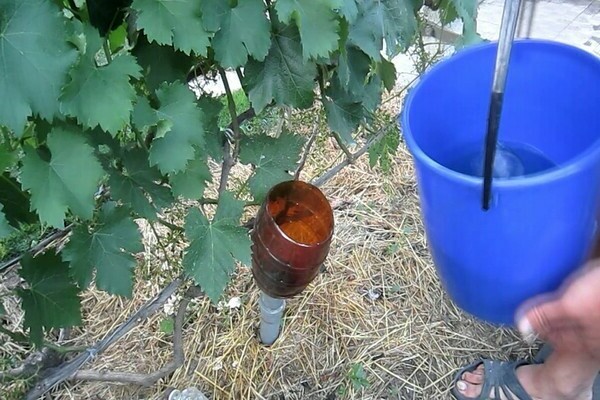
boric acid for grapes
Boron takes part in biological processes. Boron does not exist separately; it can often be found in the composition of boric acid and its salts. For example, brown is common.
Boric solutions are used:
- To stimulate seeds to germinate faster;
- In order to destroy harmful insects. The substance acts as one of the strongest poisons;
- For plant feeding.
Boron-containing substances are used in order to normalize the development of grapes.
After applying top dressing, the shrub is able to actively fight against the negative factors of the surrounding world. The amount of harvest is much higher, the vine becomes very strong. If boron is absent in significant quantities, then this causes serious damage to the plant.
Boron is one of the main trace elements for the vineyard.
How to determine the lack of boric acid in a vineyard
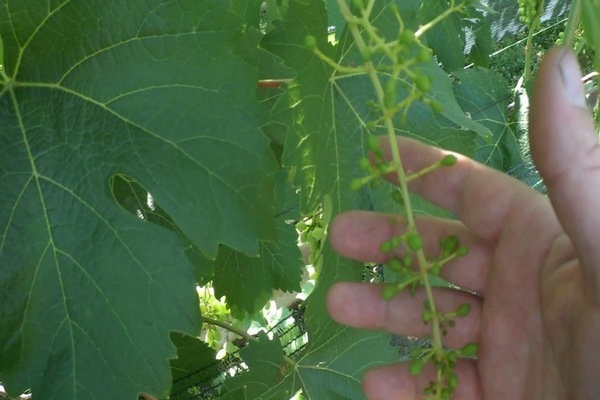
boric acid for grapes
Symptoms cannot be identified immediately and resolved quickly. But nevertheless, if the substance is lacking, the plant gradually begins to wilt. But the main task for the gardener is to learn how to determine the lack of boron in grapes.
How to determine a boron deficiency:
- Slow growth of shoots during the period of active growth;
- At the moment of active growth, the leaves appear color in the form of a mosaic;
- The leaves have a domed bend;
- The shoots are very close to each other, which looks very unnatural;
- In mid-July, the vine dies from above;
- A small number of ovaries, flowers bloom poorly;
- The inflorescences turn brown and crumble;
- The pulp turns brown, the fruits turn into peas;
- Root system starts to rot.
Experienced growers know that if a young vineyard does not get enough boric acid, it can die.
Attention: The grape bush can be fed in two ways:
- Root top dressing;
- Irrigation sheets.
The second method will bring a lot more harvest. There are many benefits to this simple method.
Boric acid for grapes - spraying shrubs
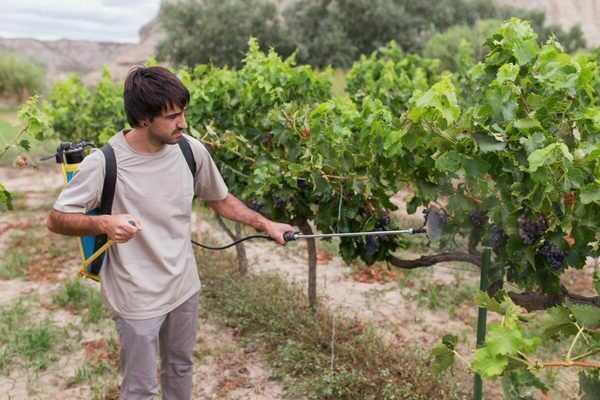
Experienced gardeners spray boron acid at the time of flower formation, emergence and saturation of the fruit with juice.
This procedure brings significant benefits:
- The shrub blooms much faster. The ovaries are strong and there are many of them;
- The root system and shoots are actively growing;
- The composition contains a large content of trace elements and vitamins. The berries have a sophisticated aroma. Fruit sizes increase significantly. Fine and tasty drinks are made from grapes, which will appeal to the most sophisticated gourmets.
- If it is rainy weather outside for a long time, then cracks do not appear on the fruits;
- The shrub becomes more resistant to bad climate conditions;
- The plant is less susceptible to disease;
- The harvest increases by 25% per year.
For irrigation, a solution is used from a mixture of zinc salt 5 grams, boric acid 5 grams and water 10 liters. This composition helps the plant to be saturated with the missing microelements and vitamins.
Advice: Dissolve boric acid in hot water. First, dry acid is added to 1 liter of water. After the solution is used in a weakly concentrated form. A solution of 0.25% is prepared from 1 liter of water, 2.5 grams of dry boron acid. First, 1 glass of hot water is applied, and then cold water is added to the required volume.
What is needed to increase the ovary
To make the ovaries and inflorescences more in the bush, it is irrigated with a solution of boric acid. This is done in the following periods:
- The solution is sprayed a week before the flowering of the bush;
- At the moment of active flowering;
- During the formation of ovaries.
Important: in order for irrigation to have a significant effect, you need to add zinc sulfate to the solution, in a 1: 1 ratio - 1 gram of substance per 1 liter of liquid.
In order for pollinating insects to actively fly up to the bush, 1 kg of sugar is poured into the solution and 10 liters of liquid are also added. Also, a second feeding can be carried out with a sugar solution at the time of flowering.
To avoid getting an infection, the plant must be treated with a special agent, which is prepared as follows:
- When cooking, you need to use 1 liter of hot water. And then gradually add cold, bringing the liquid to the desired volume;
- Dissolve 1 tbsp of boron acid in 10 liters of water;
- Pour potassium permanganate into the mixture. The liquid should turn a light pink color;
- Pour in 40 drops of iodine.
Treatment of grapes with boric acid during and before flowering
- The first way
To prepare a healing mixture, you need to take the following ingredients:
- Boron acid - 20 g;
- Urea - 25 gr;
- Kemira Lux - 20 gr;
- Iron vitriol - 10 g;
- Novosila - 60 cap;
- Potassium humate - 40 ml;
- Sugar - 3 tbsp. l;
- Citric acid -30 gr.
All substances are added per 10 liters of liquid. If a double or triple dose is being prepared, then the substances are taken in double the amount.
The ingredients must be diluted in a small amount of hot water, they must be added gradually one by one. Then you need to pour in cold water and bring the volume to 10 liters.
Attention: The solution is applied immediately or no more than 2 hours after it has been prepared.
- Second way
They are fed by this method 2 times, 1-2 weeks before flowering.
You need to use the following ingredients:
- Urea - 35 gr;
- Boron acid - 10 g;
- Ferrous sulfate - 15 g;
- Lemon - 10 gr.
Everything must be mixed in 10 liters of liquid.
Attention: Non-root feeding is carried out at the time of fruit emergence and 10 days after flowering.
- The third way
In this way, irrigation is carried out at the time of the formation of ovaries, ripening of fruits and a week before the flowering of the shrub.
A solution is prepared using 10 liters of water.
We need:
- Ammonia nitrate - 60 g;
- Ammonium sulfate - 90 g;
- Superphosphate - 150 gr;
- Boron acid -10 gr;
- Potassium sulfate or chloride - 60 g;
- Manganese sulfate - 15 g;
- Zinc sulfate 10 gr;
- Ammonium molybdate - 7 g;
- Cobalt sulfate - 0.5 g;
It is possible to irrigate plants with such a composition at the time of ripening of berries.
Feeding at the time of ripening berries
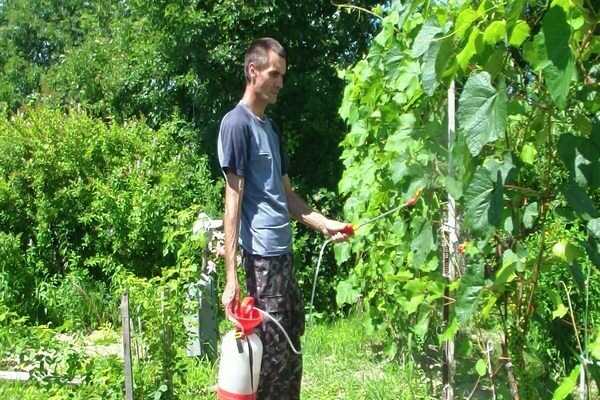
Usually the second spray is carried out during the ripening period of the fruit.
- The first way
The recipe contains the following ingredients:
- Borax or boron - 20 gr;
- Iodine - 3.5 g;
- Potassium humate - 60 ml;
- Sugar - 3 tbsp;
- Soda - 75 gr;
- Kemira Lux - 20 gr;
- Tiovit Jet - 20 g;
- Potassium permanganate - 2 gr;
- Novosil - 90 drops.
Each ingredient is dissolved in a little warm water. Then the mixture is poured into some kind of dish. You need to add cold water, bringing the volume to 10 liters.
- Second way
After the fruits have begun to set, you need to feed outside the root.
A solution is prepared using the following ingredients:
- Boron - 10 g;
- Ammonium molybdate - 15 g;
- Zinc sulfate - 15 g;
- Iron vitriol -15 g;
- Potassium permanganate -3 gr;
- Magnesium sulfate - 3 gr.
How to save the day in case of overdose
Everything should be, and this concerns the use of boron as a material for feeding.
How boric acid oversaturation manifests itself:
- On the ground are almost dried leaves with burns on them;
- The foliage is twisted inward, the color is yellow, the edges are dry;
- A sharp decline in the amount of harvest.
A large amount of boron when feeding can significantly harm. The result will be that the foliage will crumble and begin to spread the infection along the ground. The vineyard itself suffers no less.
An interesting fact is that boron, if it gets on human skin, does not cause any danger. The substance is classified as an indicator of the fourth hazard class. But nevertheless, the substance can enter the body, and have a bad effect on health.
Note to gardeners
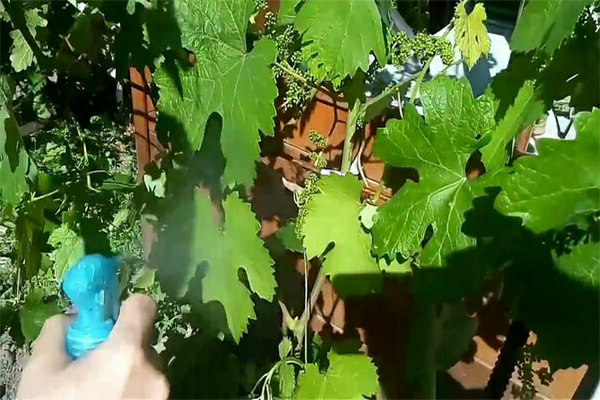
In order to carry out feeding neatly, you need to consider:
- Small droplets of the substance should fall on the foliage. To do this, the spray mechanism must be set to the minimum spray level. If suddenly the device begins to spray the plant with large drops, then it is best to stop irrigation.
- To reduce the risk of burns on foliage, the spraying procedure should be carried out in the evening or in bad rainy weather;
- The entire vineyard must be sprayed. For this, irrigation is carried out slowly and thoroughly.
Boric acid for grapes. What can replace it?
Boron fertilizers can be used as an alternative. There are varieties that dissolve in water and can be sprayed onto the plant. Also, 10 grams of borax is additionally used, diluted in 10 liters of liquid.
Experienced gardeners use Mag Bor - a substance that contains not only boric acid, but also magnesium.
Irrigation is best suited for feeding the vineyard as it is more efficient. Boric acid can be purchased by any gardener as it is very cheap.
Continuous feeding significantly improves the quality of the berries and the taste.

